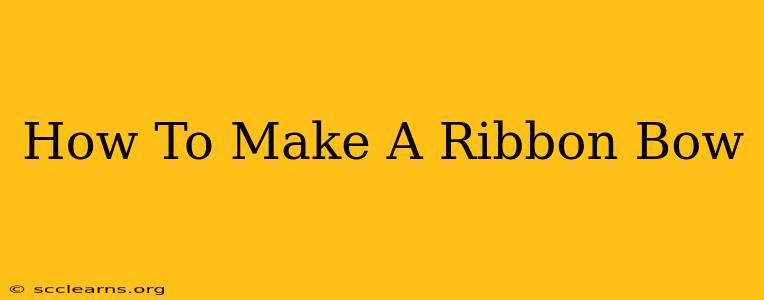Making ribbon bows might seem daunting at first, but with a little practice, you'll be crafting beautiful bows for gifts, hair, crafts, and more in no time! This comprehensive guide will walk you through various techniques, from simple to more elaborate designs. Whether you're a beginner looking for a basic bow or an experienced crafter wanting to elevate your skills, this guide has something for you.
Mastering the Basic Ribbon Bow
This section focuses on the fundamental techniques for creating a classic ribbon bow. You'll need only a few simple materials:
- Ribbon: Choose your favorite ribbon – satin, grosgrain, wired, or even fabric scraps work wonderfully! The width of the ribbon will determine the size of your bow.
- Scissors: Sharp scissors are crucial for clean cuts.
- Hot Glue Gun (optional): While not strictly necessary for a simple bow, a hot glue gun makes securing the bow much easier and more permanent.
- Floral Wire or Thread (optional): For added strength and shaping.
Step-by-Step Instructions:
- Cut your ribbon: Cut a length of ribbon. The longer the ribbon, the fuller your bow will be. A good starting point is about 18-24 inches for a medium-sized bow.
- Create loops: Fold the ribbon in half, then create a loop on one side. Make a second loop of the same size on the other side.
- Cross the loops: Cross the two loops in the center, one over the other.
- Secure the center: Tightly hold the crossed loops in the center. You can use your fingers, floral wire, or thread to secure the center. If using hot glue, apply a small amount to the center, holding the loops together until the glue sets.
- Trim the ends: Trim the ends of your ribbon to create a clean, finished look. You can leave them straight, angled, or even pointed for different styles.
Tips for the Perfect Basic Bow:
- Experiment with ribbon width: Different widths create different looks. Wider ribbons make larger, more dramatic bows, while narrower ribbons are perfect for delicate accents.
- Play with loop size: Varying the size of your loops creates a more interesting and less uniform bow.
- Consider ribbon texture: Different ribbon textures—satin, grosgrain, burlap—will result in distinct looks and feels.
Beyond the Basics: Advanced Ribbon Bow Techniques
Once you've mastered the basic bow, it's time to explore more advanced techniques:
Wired Ribbon Bows:
Wired ribbon offers superior shaping capabilities. You can create more defined loops, curves, and even more intricate designs. The wire allows for greater flexibility and the ability to hold a specific shape.
Layered Ribbon Bows:
Create a more opulent look by layering multiple ribbons of different colors, widths, and textures.
Adding embellishments:
Personalize your bows with embellishments like buttons, beads, gems, or even small charms.
Creating bows for specific uses:
Learn how to make bows specifically for hair, gifts, crafting projects, or holiday decorations. Consider the size and style of bow appropriate for the application.
SEO Optimization & Conclusion
This guide covers various aspects of creating ribbon bows, from the simplest techniques to more advanced ones. By utilizing different ribbon types, widths, and embellishments, your ribbon bow-making skills are sure to flourish. Remember to practice and experiment—the possibilities are endless! Share your beautiful creations and inspire others! Don't forget to use relevant keywords like "how to make a ribbon bow," "DIY ribbon bows," "ribbon bow tutorial," and "easy ribbon bows" when sharing your work online. This will help others easily find your content and expand your reach.

